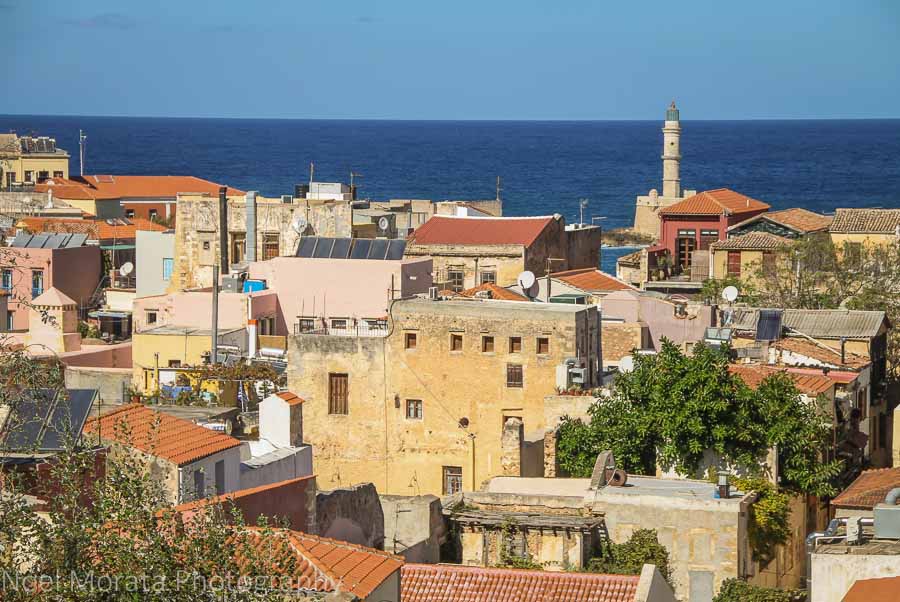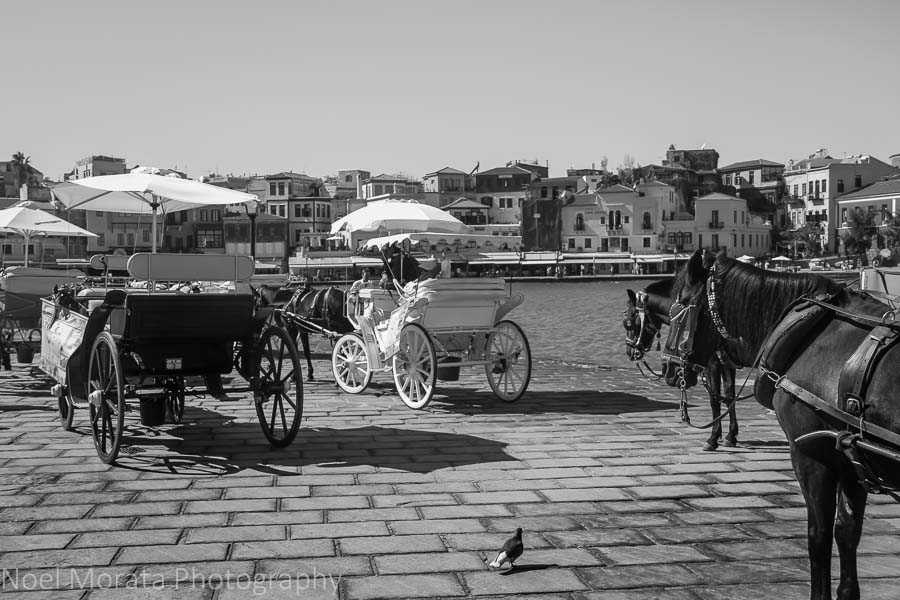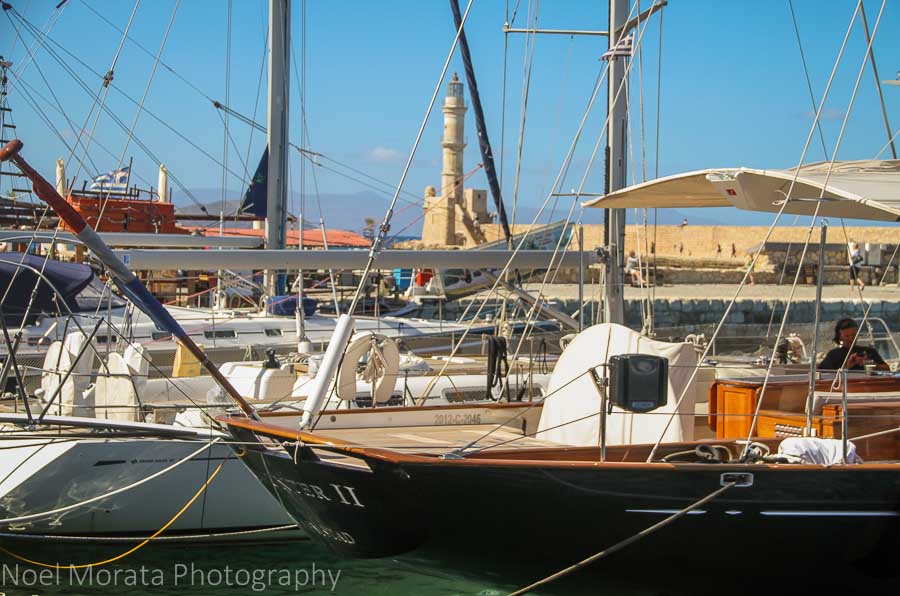Exploring Chania, Crete: Experiencehistoric and cultural sites, harbor, markets and amazing foods
Exploring Chania in the ancient capital city of Crete is perhaps one of the most visually stunning ports on the island. The city has a rich history due to many cultural influences and rulers of the Byzantine, Ottoman, Venetian, Crusaders and the early Minoan civilization along with the current Greek government. This has created any diverse architectural landmarks, monuments and buildings around the city and port worth visiting with many attractions and things to do in Chania and exploring Chania, Crete.
Many of these have been converted from their original build into newer uses based on the incoming conqueror to the island state and then later to fit tourism and local needs. You’ll see that there are many things to do in Crete starting with exploring the historic seaport of Chania.
Bookmark this post to find out more to visiting the historical city and key attractions to visiting the city below.
Where is Chania Greece located?
Chania is a captivating coastal town located on the northwest coast of the Greek island of Crete. It boasts a rich history, Venetian architecture, and stunning beaches along the Aegean Sea, making it a popular destination for travelers seeking both cultural and natural beauty.
How to get to Chania from Athens
The distance between Athens and Chania on the island of Crete can be covered by both flight and ferry:
1. Flight: You can take a direct flight from Athens International Airport (Eleftherios Venizelos Airport – ATH) to Chania International Airport (CHQ). The flight duration is approximately 1 hour. This is the quickest way to reach Chania from Athens.
2. Ferry: If you prefer a more scenic route, you can take a ferry from the Port of Piraeus in Athens to the Port of Souda in Chania. The ferry journey takes longer, around 8 to 9 hours, but it offers beautiful views of the Aegean Sea.
The mode of transportation you choose will depend on your preferences, schedule, and whether you prefer a faster or more leisurely journey to Chania.
What to do and see in Chania town
The city views are stunning looking down to the old town and harbor area (below). From a higher vantage point, you can start to see some of the main points of interest and monuments that create the city’s skyline.
Part of the fun of exploring the different streets is just getting lost around Chania and discovering any interesting landmarks or gorgeous vista like the harbor view below.
Along the way you’ll find the many public squares, the colorful harbor area, narrow streets, the public market and so many restaurants that you need to try some of the local specialties.
Here’s some of the highlights below.
Crete Harbor area
Exploring Chania’s historic harbor area is a wonderful place to d view and walk from one end of the waterfront all the way down to the docks where large private yachts and boats are moored. The picturesque waterfront area is lined with outdoor cafes and bars, all selling fresh seafood and local Greek specialties, it’s fun to explore the Greek menus to find something that sounds unusual and stands out from all the tourist menus offered. The entire harbor is colorful with all the different shaped buildings right on the edge of the vivid blues in the harbor. Created initially by the Venetians in the 14th century, the port was built for commercial purposes and fortified to protect the city from any raiding pirates during that timeframe.
Towards the opening of the harbor is the lighthouse designed in Moorish style with flourishes (below). It is noted for being one of the oldest lighthouses in Greece and was originally built by the Venetians between 1595-1601. Later changes where made by the Egyptians between 1831-1841, when they added a Moorish influence with a Minaret style tower to the base.
On the other side of the harbor fronting the lighthouse is Firkas fort, also built by the Venetians to protect the city from pirate invasions. The fort used to house the Venetian naval guards and is now used as the Maritime museum, offering a collection of artifacts and objects. The museum shares the rich history of Chania’s port from the early Venetian rule and influence through other occupations.
The small attractive port of Chania
Carriage rides for hire at Chania’s harbor
Colorful yachts docked in Chania’s port
Here’s a look at Chania harbor and some main attractions
Chania’s many different churches
It’s fascinating seeing the many religions that are practiced on the island from Islam, to Catholic, Greek Orthodox and to contemporary religions which all live cohesively in these tight spaces. The main Greek Orthodox basilica (above) also known as the Church of the Trimartyri sits prominently in Plateia Mitropoleos. The factory sits on the site of an Venetian church which was later converted to a soap factory by the Turks.
There is a legend involving the Virgin Mary and an icon of her stored in the soap factory. The Virgin Mary showed up as an image to the workers saying that she did not want her ‘holy’ house to be a soap factory, disturbing the workers and one of them who took the icon away for safety. As the legend continues, the owner’s child soon afterwards fell into a nearby well and the owner prayed to the Virgin for help to rescue his child. He promised to give the factory and proceeds to build the church again for the Virgin Mary, miraculously the child was saved. The owner lived to his promised and the church now standing is the Greek church we see. The icon of the Virgin Mary was later returned and is located inside the church for viewing.
The main altar at Church of the Trimartyri
Walking along Chania’s small promenades and passage ways is an eye opener, in a good way. You will find a variety of Cretan, Venetian and Ottoman influences all mixing in the narrow alleyways that makes these discoveries so fascinating. Many of these have been repurposed into cafes, shops and galleries to attract the tourist crowds but many local shops and sundry stores still exist for locals to shop daily. It’s a nice combination of tourist attractions with real daily life and shopping to make exploring the area authentic and stimulating to visit the many streets around Chania.
Just a few of the major Islamic buildings remain and all have been repurposed into cultural attractions, galleries or in the case of the main Islamic temple below, converted into a catholic church. Chania’s history is rich with many invaders adding on to the architecture, culture and the delicious food from so many regions that ruled this island. The city is filled with an amazing history that is complex and filled with so many influences that make it what it is today.
Chania’s public market at the Agora
Just outside the historic old town is the public market inside a large cross shaped building called the Agora, and it is huge. Offering a huge array of local delicacies, fresh seafood, perishable fruits and vegetables and other specialty foods, the market is the place to visit to see the foods grown produced and made on the island of Crete.
The market also houses some small Greek restaurants offering some delicious specialties of the day worth trying out. The market is a wonderful place to see daily life, try something interesting or even eat at one of the cafes on site. The best part for me is taking some beautiful pictures of the market and showing the abundance of food produced or grown locally. If you’re hungry, check out all the best Chania restaurants for all these authentic and local foods from the island.
Specialty foods and dishes to try in Chania, Greece
Chania, Greece, offers a delectable array of specialty foods and dishes that showcase the flavors of Crete and Greek cuisine. Here are some must-try items:
Dakos:
A traditional Cretan meze made with dried barley rusk, ripe tomatoes, feta cheese, olives, and olive oil. It’s a simple yet delicious starter.
Chaniotiko Boureki:
A local specialty featuring layers of sliced zucchini, potato, and myzithra cheese, baked to perfection.
Kalitsounia:
Sweet or savory pastries filled with various ingredients like cheese, herbs, or honey. They’re often enjoyed as snacks or desserts.
Sfakian Pie (Sfakianopita):
A thin, crispy pie filled with local cheese (usually mizithra or feta) and served with a drizzle of honey.
Kleftiko:
A flavorful dish of slow-cooked lamb or goat, typically seasoned with herbs and cooked in parchment paper or clay pots.
Bougatsa:
A sweet pastry filled with custard, cheese, or sweet cream. It’s often enjoyed as a breakfast treat.
Fresh Seafood:
Given Chania’s coastal location, indulge in fresh seafood dishes like grilled octopus, fried calamari, or fish soups like kakavia.
Tzatziki:
A classic Greek dip made from yogurt, cucumber, garlic, and herbs, often served with bread or as a side to various dishes.
Chorta:
Wild greens or herbs, often sautéed with olive oil, garlic, and lemon juice, making a nutritious and flavorful side dish.
Raki:
A traditional Cretan spirit often offered as a welcoming gesture in local tavernas. It’s typically enjoyed as a digestive.
Cretan Olive Oil:
The region is known for its high-quality olive oil. Try it drizzled over salads or used as a dip for bread.
Staka:
A rich and creamy dairy dish made from sheep’s milk, often served with bread or poured over other Cretan dishes.
Honey:
Crete is famous for its honey, especially thyme honey. Enjoy it drizzled over yogurt, cheese, or pastries.
Greek Coffee:
Sip on traditional Greek coffee, often served strong and sweet. It’s a delightful way to end a meal.
Greek Wines:
Explore local Greek wines, particularly those from Crete. Sample reds, whites, and rosés made from indigenous grape varieties.
Chania’s culinary scene combines the freshest ingredients with time-honored traditions, offering a rich tapestry of flavors. Whether you’re savoring the bounty of the sea or indulging in sweet pastries, the cuisine of Chania will delight your taste buds.
There are lots of fresh local seafood for sale every day
What to eat in Chania, check out these suggestions
Chania street scenes
Weather and best time to visit Chania
The best time to visit Chania, Greece, largely depends on your preferences for weather and crowd levels. Here’s an overview of the weather and the recommended times to visit:
**1. Spring (April to June):**
– Spring is a lovely time to visit Chania. The weather is mild and comfortable, with temperatures gradually warming up.
– Blooms of wildflowers and lush landscapes make it ideal for nature enthusiasts.
– This season offers a quieter and more relaxed atmosphere compared to the peak summer months.
**2. Summer (July to August):**
– Summer is the high tourist season in Chania, with long, sunny days and warm temperatures.
– The beaches are in their prime, making it perfect for swimming and water activities.
– Expect larger crowds, especially in popular tourist areas and on the beaches.
**3. Autumn (September to October):**
– Early autumn is an excellent time to visit Chania. The weather remains warm, and the sea is still inviting for swimming.
– September offers pleasant temperatures and fewer crowds than July and August.
– October is cooler, but it’s a great time for hiking and exploring without the summer heat.
**4. Winter (November to March):**
– Chania experiences a mild Mediterranean climate in winter, with cooler temperatures and occasional rainfall.
– While not the best time for beach activities, winter can be appealing for those who prefer fewer tourists and a more peaceful experience.
– Some businesses, especially beachfront establishments, may close during the off-season.
In summary, the best time to visit Chania for a balanced experience of pleasant weather and manageable crowds is during the spring (April to June) and early autumn (September). These periods offer the opportunity to enjoy both outdoor activities and cultural exploration without the intense heat and crowds of the peak summer months.
A view of Chania from the Minoan hill
Looking inland from the Chania Minoan hill
Here’s a fun walking tour of the city without an commentary below, just a fun tour
Where to stay in Chania, Crete
There are many coastal communities to stay around the island, but you’ll find the majority of inns and hotels around the two larger cities of Chania and Heraklion.
You can also check into Air Bnb accommodations all around the island with both cities central to visiting all the different areas around the island. For reviews and current prices in Chania, Check out these Trip Advisor reviews here for an updated calendar and availability.
Want to see more of Crete, check out these additional posts below
Conclusion to Exploring Chania, Crete
Hope you enjoyed the tour and checking out this post on Exploring Chania, Crete. If you enjoyed the post, please share it with any of the social media buttons located around the post, thank you.
Disclosure – There are affiliates links on this posts which provide a small commission to support this site at no extra cost to you. Thank you for reading, and happy travels
If you like what you see, come and check out my other social media channels for more updates, including Instagram, Pinterest and Twitter

























Amazing place and pictures
Thanks for commenting and I love Chania also, such amazing history
Incredible places and photos are perfect for congratulations
Thanks for the good writeup. It actually was a amusement account it. Glance complicated to far brought agreeable from you! However, how could we communicate?
Good site you have got here.. It’s hard to find excellent writing like yours these days. I seriously appreciate individuals like you! Take care!!
Great post. Amazing sunny captures.
I love Crete very much it is a hidden gem for traveling in Greece. Chania is beautiful I really liked St. Niklaus and the history. I really appreciate the pics pointing out the Moorish flourishes and touches. Awesome! We were in Crete and put up a trip report covering Chania, Heraklion, and Matala – http://bigandsmalltravel.com/2014/10/14/photophiles-volume-iv-the-crete-edition/
Wonderful diversity of photos. Chania, Crete reminded me of Croatia. I think I need to put this gorgeous place on my “must-see” list!
I visited Chania many years ago, and I remember that wonderful mixture of history, modern Greek culture and of course the deep blue sky. Thanks for reminding me of it.
Noel, once again I am blown away by your “you are there” photos. The one of the woman lighting the candles in the church is especially wonderful. We recently traveled in Turkey and Israel and the layers you discovered in Chania sound very familiar.
Isn’t Greece just lovely! Thank you for all of your recommendations on Chania, its officially on my bucketlist 🙂 Kat x
Since I’ll probably never make it to Chania, Crete, it was a treat to visit it with you just now through your images.
this is a area I would really love to visit. Hopefully one day. Europe is so far away for us in Australia. In the meantime, thanks for the wonderful images.
Reading this, Noel, I was all “oh, that looks like Mallorca,” “oh, that looks like Barcelona,” “oh, that looks like Dubrovnik or Istanbul,” on and on. Such a wonderful blend of diversity and this eastern Mediterranean light was made for your lens. Beautiful.
The colors of the buildings and water in Crete look so inviting but your photography makes everything appealing:-)
I’ve always wanted to visit Crete. Your photos of Chania have just reinforced that. I love the history and cultural influences.
I didn’t quite realise the influence so many cultures had on Chania. No wonder it looks an interesting town with some wonderful architecture. The markets would be my first stop…the food looks wonderful! I still remember many of the Cretin salads that I ate in the Greek islands!
I really so excited to visit Greece. Unbelievable places. Magnificent shot with great angle. Thanks for sharing with us.
Chania, Crete appears to be a city with one foot in the past and another in the present – a huge melting pot with many cultural influences and a rich history. This is exactly the kind of city I love to explore and learn about its past and the photos show a thriving city. I especially like your pics of the narrow alleyways and local markets.
Chania looks gorgeous! I’ll be in Crete next June to lead a workshop. I hadn’t really thought about the place, but now I’ll make sure to add a couple of days so I can explore it too!
I didn’t realized that the Venetians had so much influence in Crete. I expected Chania to look all white and blue like Santorini. What you showed us is lovely. I like that you pointed out the various architectural influences. And oh my, look at all that cheese.
Beautiful photos. I was there more than ten years ago I think and loved to remember that trip with the help of your photos.
It looks very rustic! Very different from the other islands I’ve visited in Greece. Still beautiful though. 🙂